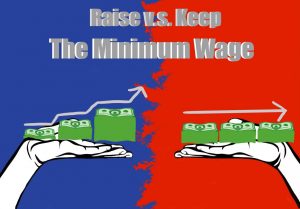Minimum Wages Should be Raised
March 22, 2021
The federal minimum wage of the United States hasn’t been raised since 2009 and for covered nonexempt employees the wage stands at $7.25 per hour. While each state has the right to establish their own higher minimum wages, the federal minimum wage rates needs to increase in the coming years.
On March 5th, an open vote in the Senate proposing to increase the federal minimum wage took place, settling with a vote favoring those against the provision. Included in President Biden’s $1.9 trillion stimulus plan, the proposal was quickly averted by Senate arbiter Elizabeth MacDonough. The Democrats who voted against the minimum wage raise signified that once Biden’s stimulus plan is revised, they will open up to working out the proposal.
While the official raise of the federal minimum wage is still in dispute, increases have gradually started already in some states such as California and Florida. Though the wage is set at a minimum of $7, most states have set higher standard wages and most minimum wage workers make around $11.80 per hour.
So why should the federal minimum wage be raised if most states have already naturally risen them themselves? According to the Economic Policy Institute, if the federal minimum wage is increased to $15 by 2025, pay would be lifted for 32 million workers, initiating the turning point of reversing decades of growing pay inequality.
Among the workers that this pay would be lifted for, many people of color would seek improvement in equal paying and treatment. With where the current minimum wage stands, BIPOC workers, especially women, are typically underpaid due to systemic sexism and racism.
“In addition to being older, low-wage workers are much more likely to be a woman or person of color than the average worker. As a result, our current national minimum wage of $7.25 hurts women as well as black and Hispanic workers the most. Nearly 56 percent of those who would benefit from a $15 minimum wage in 2024 are women, despite women making up only 48 percent of the total U.S. workforce,” said the EPI.
Along with the inequality the current federal minimum wage imposes on workers of color and women, small businesses are also at a disadvantage. When COVID-19 emerged at the beginning of 2020, small businesses were hurt and operation rates decreased by almost 34 percent.
“Small businesses are a crucial part of the U.S. economy, employing about one-third of the workforce, according to the most recent available data. As a result, small businesses are a crucial part of the recovery and need meaningful federal aid to rebuild,” according to the Center for American Progress.
Additionally, a raise has never resulted in an immediate issue such as direct job losses. If anything, increasing minimum wage would help spur the economy, job growth, and productive activity. For example, the Institute for Policy Studies states that “for every extra dollar going into the wallet of a low-wage worker, about $1.21 is added to the overall economy.”
Beyond the threats and damage the current wage does and can do, it is only reasonable for it to be raised. Our economy would not fall or suffer just from gradually raising the minimum wage to $15. In fact, the economy is more than capable of supplying the expenses and the wage would be well over $20 an hour nowadays if it had increased following the rate of productivity growth since 1960.
Overall, increasing the federal minimum wage has far more benefits than drawbacks such as economic improvement and gains for all workers, making the proposal the most logical decision in the years to come. While the financial condition and general well-being of our nation begins to recover from the pandemic, a gradually enlarging raise would significantly help everyone.


